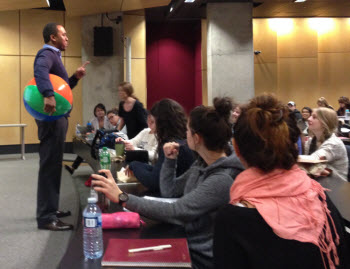Two years ago, we contributed to a presentation at what was to be the last “AAHPERD” convention in St. Louis, Missouri with a group of colleagues from the Diversity and Inclusiveness Task Force of NASPE. The presentation, Innovative Teaching Practices in Physical Education for Diverse K-12 Schools, gave us an opportunity to present a segment entitled Cooperative Games That Embrace Diversity.

After the presentation and the great discussion with attendees that ensued, we decided to revisit what we presented this past fall at our respective schools in an adventure education skills and secondary methods course. The main themes from the lesson included the language of acceptance of all cultures, critical thinking, creating interactions, intervening on student remarks, and modeling behavior for students. With these tools in place, we led our classes through some transformational work that resulted in students having a better understanding of the concepts of inclusionary and exclusionary speech as well as appreciating differences in others to the betterment of the whole. Our session ended with the quote, “We’re better together than we are apart.”
It occurred to us that what we learned might make for a nice article as we head into another school year, particularly in light of the current political landscape that has served as a poor model for youth on how to discuss and accept differences. With this in mind, we would like to present a few examples of what we taught our students with some notes preceding the activities and how we facilitated them.
Two Things About Me
Point of Emphasis: Understanding the role of insider and outsider can create avenues for persons from different cultures to have voice that leads to more effective learning situations (Culp, 2013).
We first began with an activity that looked at the uniqueness of each individual in our classroom setting called “Two Things About Me.” In this activity, each member of the class identifies two facts that represent him/her distinctly that immediately come to mind. For example, “I’m a collegiate baseball player” or “I come from a family of six.” They can either write these things down or just commit them to memory. The next part of the activity sees these folks paired up with another classmate to share what they’ve come up with to distinguish/describe themselves. In this portion of the activity one partner tells the other their “two things” and in turn hears their partner’s “two things.”
Together the partners decide if the “two things” are inclusive or exclusive in nature. For example, an inclusive fact might be something such as, “this is my first day of school at a post secondary institution.” Many other members of the class are also going to be experiencing this phenomenon in a 100 level course and so would feel included in that distinguishing remark. An exclusionary example on the other hand might be something like, “I’m originally from a city in Canada.” Although NCCC is close to the Canadian border we don’t have as many Canadians in our classes as you might think (usually just one or two if any). This comment would then be considered more exclusionary in nature. Identifying how we think of ourselves in relation to the folks around us can begin to help us see how we can be more inclusionary in our thought processes in groups versus exclusionary. This may help to facilitate an environment of unity versus division right at the start of your school year.
Rock Hopping
Point of Emphasis: Physical education taught in a positive and nurturing learning environment benefits all youth, in particular transient youth, as it can break down falsehoods and provide a “sense of belonging” that can combat feelings of emotional stress (Culp, 2014).
Another activity we introduced on our respective first weeks when discussing the plight of transient youth, was called “Rock Hopping” (known in some circles as “Have You Ever”). The basic premise is simple. All students stand in a large circle formation, take off one of their shoes and stand beside it. The teacher selects one student to go to the middle with their shoe (you could opt to take volunteers, play “noses,” your choice, etc.,) and asks this student to share something with the class that they have done before that was fun, interesting or exciting in some way. The student stands in the middle, asks, “Have you ever?” and is then allowed to move once they have asked the question. The folks around the circle have to move to a different vacated shoe if they have also participated in the activity described by the person in the middle. All of those who have left their shoe/rock must scramble around the circle until the last open shoe remaining is the one in the middle; which would then provide a new person to ask, “Have you ever?”

Participants who did not have the experience described must stay at their shoe/rock and wait for another opportunity to move/hop around the open space to find an open shoe/rock. This particular initiative provides the class with support when they see how many folks have “finished a 5k race,” “gotten a D before,” or “been out of state on a trip.” Additionally, folks begin to share some of the things that far less people have done like, “left the country,” “won a championship,” or “sung in front of a crowd” which invariably starts conversations that lead to a deeper appreciation and respect for fellow classmates.

Captain’s Calling
Point of Emphasis: Upon entering any environment, persons from different backgrounds will often access the environment based on three questions: 1) Can this place be mine or adjusted to me? 2) Can I produce results here? and 3) Can I relate to and get along with others who are here? These basic aspects may not often be expressed until individuals have the opportunity to talk to one another (Culp, 2009).
Finally, the last episode we would like to share with you is that of “Captain’s Calling.” Many of you may be familiar with Captain’s Calling (not to be confused with “Captain’s Coming”) but may not be familiar with the easy opportunity it provides to place students on a level cultural playing field. In the NCCC-version, nautical terms are first defined for the students. The wall in front is labeled the “bow,” while the wall behind is labeled the “stern.” The wall on the left-hand side is labeled “port” and the wall on the right is called “starboard.” Students who are last to get to these walls as they are called out must go “overboard” (a designated spot to stand by the outer walls of the gymnasium).
In addition to learning this new directional vocabulary, students are taught to do the “Captain’s Boogie” with a partner that they select. “Man the Life Boats” with a group of three. Eat at the “Captain’s Table” with a group of four. And form a “Starfish” with a group of five. When each command is given the class must scramble to accomplish the task before they are left out and cast “overboard” (where they can wait and do activities if you’d like). Races to “the bow” or “port” can cast the last student to the side “overboard”, just as not finding enough people to “Man the Lifeboats” can. One-by-one the class members go “overboard” as they are not able to keep up with the directions. But when the teacher identifies four or more members of the class being left out he/she calls “Sailors Overboard” at which time members of the class walk/jog to those who are out, link arms and bring them back to the “crew”.
This activity offers an opportunity for the new classmates to operate on an even playing field (joining with familiar cliques becomes harder as folks are eliminated, which creates new alliances). Additionally, a lack of familiarity with the vernacular puts most everyone on an equally uneven footing upon which to navigate the tasks. Discussing this lack of comfort in the post-activity processing can be guided to have students more deeply understand what elements they are culturally used to understanding every day, and how some of their classmates might not have the advantage of those same cultural norms.
Conclusion
When introducing these activities to teach for a greater understanding of difference in classes, we think it is important to keep in mind that it is impossible to know and subsequently meet the needs of each student consistently every day. What is important is the effort and the commitment to being intentional. Too often, many good educators view the teaching of difference as unnecessary or an issue that is of no concern to them. However, schools are sites of interaction that should be nurturing, safe, and stable. We hope this article has provided some ideas to reinforce positive interactions in your respective programs.
References:
Culp, B. (2014). Migrant and Military Students: Mobility and promoting effective physical education. Strategies: A Journal for Physical and Sport Educators, 27 (5), 38-40.
Culp, B. (2013). Eliminating barriers to physical activity participation using cultural negotiation and competence. Strategies: A Journal for Physical and Sport Educators, 26 (3), 35-40.
Culp, B. (2009). Are your S’s in effect? Ensuring culturally responsive physical education environments. Strategies: A Journal for Physical and Sport Educators, 24 (2), 10-14.

